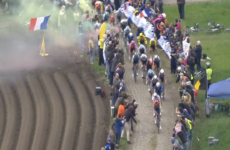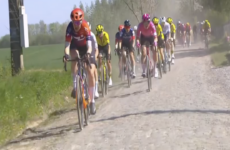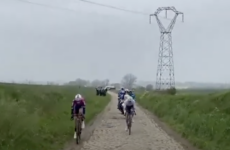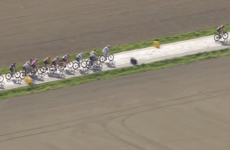Description
April 13, 2025
122nd Paris-Roubaix 2025 🇫🇷 (1.UWT) ME – Compiègne – Roubaix : 259,2 km
Paris–Roubaix [pa.ʁi.ʁu.bɛ] is a one-day professional bicycle road race in northern France,
Show more...
April 13, 2025
122nd Paris-Roubaix 2025 🇫🇷 (1.UWT) ME – Compiègne – Roubaix : 259,2 km
Paris–Roubaix [pa.ʁi.ʁu.bɛ] is a one-day professional bicycle road race in northern France, starting north of Paris and finishing in Roubaix, at the border with Belgium. It is one of cycling’s oldest races, and is one of the ‘Monuments’ or classics of the European calendar, and contributes points towards the UCI World Ranking. From its beginning in 1896 until 1967, the race started in Paris and ended in Roubaix; in 1966 the start moved to Chantilly; and since 1977 it has started in Compiègne, about 85 kilometres (53 mi) north-east of the centre of Paris. Since 1943, the finish has for the most part taken place in the Roubaix Velodrome. The race is currently organised by the media group Amaury Sport Organisation, and takes place in early April, usually on the second Sunday. It has been called the Hell of the North, a Sunday in Hell (also the title of a film about the 1976 race), the Queen of the Classics or la Pascale: the Easter race. Since 1977, the winner of Paris–Roubaix has received a sett (cobble stone) as part of his prize.
Mathieu van der Poel (Alpecin-Deceuninck) has soared to his third straight victory in Paris-Roubaix after a crash and high-tension pursuit by Tadej Pogačar (UAE Team Emirates-XRG) ended with a solo triumph for the Dutchman.
Pogačar and Van der Poel were leading the race with some 40 kilometres to go when the Slovenian fell hard on a right hand bend on sector 9, suffering injuries in his left wrist and being delayed when he needed a replacement bike, with a subsequent front wheel puncture then compounding his woes.
Despite having a bidon flung at his face and a late puncture of his own on the Carrefour d’Arbre forcing him to change bikes, too – with his first being run over the team car just metres behind – Van der Poel kept his cool and rode a near-faultless finale. In the process he became the eighth rider in Roubaix history to win the Hell of the North three times, and the first since Francesco Moser in 1980 to take three editions in a row.
Pogačar faded slowly but surely, and crossed the line around 1:20 behind Van der Poel, with Mads Pedersen (Lidl-Trek) taking third by outsprinting Wout van Aert (Visma-Lease a Bike) and Florian Vermeersch (UAE Team Emirates-XRG).
“It’s such a hard race and I was really suffering, too bad Tadej made this mistake on a corner,” Van der Poel said afterwards.
“But then I just had to go for it and it was still quite far from the finish, it was really hard especially with the last two sectors with the headwind. I was really struggling but I’m happy to make it to the finish line.”
As for when Pogačar crashed, he said, “the speed was superhigh and I think he misjudged the turn a bit. I was just quick enough to save it, and then I don’t know what happened afterwards, because I had quite a big gap but I had to go for it. That’s part of racing.”
Van der Poel suffered a puncture “and I didn’t know the time gap, because my radio didn’t work, so I couldn’t ask for it or say I had a flat tyre. It took a while til the car was there but it all worked out in the end.”
There was no sense of revenge after losing Flanders to Pogačar he said. “I’m just happy that I could find my good legs again. But we all know what an incredible champion Tadej is, what he did here in his first Roubaix- it doesn’t surprise me but it’s also not normal, he’s just an exceptional talent.”
“Probably it would have been the two of us going to the velodrome if he doesn’t make that mistake so I guess we’ll see him back here next year to take his revenge.”
A searing attack by Pogačar at 72km to go on the Tilloy sector brought across Van der Poel and his Alpecin teammate Jasper Philipsen, reducing the race leaders to just three. Pedersen was unlucky enough to suffer a puncture just as the Slovenian made his move, while another top favourite, Van Aert had crashed early on, only bouncing back in the final battle for third.
45 kilometres from the finish, a duel of effort between Van der Poel and Pogačar began, and the two top pre-race favourites forged on. However, Pogačar then was unlucky enough to crash, leaving Van der Poel ahead and alone at the head of the field.
Van der Poel had his own issues, with a bottle thrown at the Dutchman’s face with 33 kilometres to go and a puncture on the Carrefour d’Arbre. Nothing, though, could stop Van der Poel from heading home into the velodrome to clinch the eighth Monument of his career, and after Milan-San Remo earlier this spring, the second of this season.
How it unfolded
Following the heavy overnight rain, racing got underway in dry, overcast conditions, with Jonas Abrahamsen (Uno-X Mobility) launching the first of a flurry of early attacks. Ten riders then attempted to move ahead, including former Milan-San Remo podium finisher Ben Swift (Ineos Grenadiers) and Rasmus Pedersen (Decathlon AG2R La Mondiale). But UAE Team Emirates and Visma-Lease a Bike were seemingly determined either to put a rider in the break or ensure not dangerous riders went in it, and each time the early bids were sucked back.
Finally a group of eight that met with general approval from Roubaix’s unofficial powers-that-be went up the road after almost 30 kilometres of skirmishing, with Pogačar personally chasing down a counter-move that tried to bridge across. Kim Heiduk (Ineos Grenadiers), Oier Lazkano (Red Bull-Bora-Hansgrohe), Markus Hoelgaard (Uno-X), Jonas Rutsch (Intermarché-Wanty), Max Walker (EF Education-EasyPost), Jasper De Buyst (Lotto),Rory Townsend (Q36.5 Pro Cycling) and Abram Stockman (Unibet-Tietema Rockets) all got the UAE/Visma green light. It was certainly a strong break, but barring Lazkano, perhaps, a former winner of Spain’s closest equivalent to Roubaix, the cobbled Clásica Jaén, their chances of long-term glory were slim.
With average speeds of just over a jaw-dropping 51 kph in the first hour, the eight-man break of the day nonetheless managed to open up a gap of three minutes on the long, flat approach roads to the first of the 30 sectors of cobbles. Meantime Movistar were having a miserable start to the race, as Mathias Norsgaard had the dubious honour of being the first rider to abandon the 2025 edition Paris-Roubaix, then teammate Manilo Moro and Albert Torres both quickly following him after crashes, and even before they’d reached the cobbles.
Things were going better for the break, which rattled onto the opening pavé at Troisville, led – unsurprisingly – by Lazkano, with a healthy three minutes’ advantage. As the bunch hit top speed to tackle the initial sector, the first big crash of the race took place, too, when two-times Roubaix runner-up Philipsen and fellow Belgian Classics specialist Jasper Stuyven (Lidl-Trek) both came down on a greasy left-hand corner.
The first sector of Paris-Roubaix always causes an inordinate amount of damage and this year was no exception. Other top favourites like Van Aert and Filippo Ganna (Ineos Grenadiers), the former due to a crash, the latter through a puncture, also found themselves in trouble and off the back. But both fought hard to regain contact, Van Aert quickly succeeding thanks to support from his teammates, Ganna and Philipsen much less so, but it was all a foretaste of what was to come.
Lidl-Trek drove hard to maintain the pace in the pack, but when Alpecin-Deceuninck added their shoulder to the collective wheel alongside the German squad, they nonetheless took it fairly gently to allow Philipsen and Ganna’s large chase group back on board. Meanwhile, Pogačar, always staying close to the front, showed he was ready for any development and staying out of trouble.
A holding pattern seemed to emerge after Ganna and Philiipsen’s group regained contact, and the break still stubbornly held on to a two minute advantage as the race hit the 25th sector of cobbles, Verchain-Maugré to Quérénaing. Ineos Grenadiers, given Ganna’s return, then added more firepower to the peloton’s chase thanks to young British duo Sam Watson and Josh Tarling. Then even as the crunch sector of Arenberg approached, the peloton’s pace, which was never that low, once again began to rise remorselessly.
Barring Ganna and Philipsen’s difficulties, which they had both resolved, and a big question mark hovering over Van Aert, the first half of 2025 Paris-Roubaix had thus developed fairly as much as expected. Ahead of Arenberg, UAE, Deceuninck-Alpecin, Lidl-Trek, Ineos and Visma were all still present in significant numbers in a very large main peloton, and little had unsettled their pre-race strategies of getting the top names ready for the main Roubaix battlegrounds well-placed and supported.
Coming onto the four-star Haveluy, sector 20 and the ‘prologue’ for Arenberg, though, that was all about to change. Pedersen’s first big acceleration of the race brought about a marked rise in speed, and when the response came from one of the top players in person. Pogačar shot past Pedersen’ right, Van der Poel then poured fuel on top of the Slovenian’s acceleration. By the time they came off the Haveluy, only 20 riders or so remained in the front group and the real Roubaix selection process had begun, even if of the favourites, Ganna was missing once again.
Arenberg forest
The leading early break still had 20 seconds on a rapidly reformed main peloton as they hit the forest. But when Pogačar once again accelerated hard at the front, forcing a 15-strong group clear alongside Van der Poel, it was clear the early movers were doomed.
Sure enough, the two big favourites weaved their way through the last remnants of the breakaway as they came off the much-feared Arenberg sector, fortunately without any incident despite the clear difference in speed. Then when Van der Poel briefly pressed home their advantage on the roads beyond, further shredding the small group of race leaders, it looked like a really important break had formed.
By the time Van der Poel ceased powering away, only Philipsen, Stefan Bissegger (Decathlon AG2R La Mondiale), Pedersen and Pogačar were with him. Pogačar signalled for his team car, receiving a timely gel, and as they reached sector 18 and another feed zone, the two Alpecin riders, first and second last year, ensured the gap on 14 chasers remained at nearly a minute away.
Such was the power of the front group, containing all three top finishers from Paris-Roubaix 2024 plus Pogačar, the win increasingly seemed more and more likely to come from these five race leaders, despite Van Aert pushing on as hard as possible in pursuit.
On sector 15, Pogačar suddenly opened up a colossal acceleration, forcing Bissegger to chase and then – finally – Van der Poel to accelerate. Pedersen had the extreme bad luck to puncture just as the crash happened and suddenly, with as much as 70 kilometres to go, the lead group was down to the two main pre-race contenders: Van der Poel and Pogačar.
Who had the advantage? Van der Poel had the perfect excuse not to work though, given Philipsen was behind and he immediately bridged across, while Van Aert and Pedersen joined forces behind in a group of 12 also containing Stefan Küng (Groupama-FDJ) and a very impressive Brennan, the youngest rider in the race. As the race moved into its finale, Pogačar was – for once in his career – outnumbered by his Alpecin rivals, both of them considerably more successful in a Roubaix where the UAE racer was making his debut, so had no previous experience to help him.
The 60-kilometres-to-go mark, where Van der Poel had launched his winning move last year, came and went and rather than attacking instead the trio – all of them guaranteed a podium spot, after all – concentrated on refuelling and keeping their advantage open. Then on the dangerously long Mons-en-Pevele segment, five stars strong, Pogačar pushed harder at the head of the trio, but neither Alpecin rider, despite Philipsen’s visible injuries, was seemingly unsettled.
Final sectors
That changed when Van der Poel also tested the water, and a second punch by Pogačar on the Mons-en-Pevele abruptly left Philipsen, his injuries visible from his early crash, flailing at the back. Van der Poel and Pogačar two continued onwards with an uneasy truce, and Van der Poel later said he expected the two of them to go all the way together to the finish. But then the real game changer happened some 40 kilometres from the finish, a sudden miscalculation at a right-angled bend on the comparatively easy sector 9 saw Pogačar go flying.
Fortunately unharmed, the Slovenian’s nonetheless chain came off, and he fought to put it back on, finally managing to get a replacement bike from his team car and losing 20 seconds in the process. Although blood seeped from his left wrist, he could hold his handlebars when he remounted without any difficulties, and Pogačar managed to chase on alone and undeterred, with seven sectors and 30 kilometres remaining, it looked like Van der Poel might yet have a fight on his hands.
For several kilometres and in shades of Johan Museeuw’s epic pursuit of Andrei Tchmil in the much muddier conditions of the 1994 Roubaix, Pogačar could see the following cars ahead and at one point the gap came down to just 16 seconds. But just like in 1994, slowly but surely Van der Poel carved open a bigger and bigger gap, and then when Pogačar had a front-wheel puncture, it was effectively game over.
To his immense credit, rather than sit up or wait for a chase group, World Champion forged on determinedly, although he did take the corners rather more carefully than before his crash. First in Flanders a week before, second in Roubaix in his race debut was by no means a disgrace, even if the much awaited final duel with Van der Poel had been snuffed out by his apparent miscalculation on that illfated corner.
Van der Poel was having issues of his own, meanwhile, after a roadside spectator opted to launch a bidon at his head on the Carrefour d’Arbre. Fortunately it had no effect and he barely paused in his effort, but the puncture that then followed looked far more spectacular, as the following car was so keen to give him his replacement bike, it ran over the one he had just dismounted.
The gap on the fading Pogačar did nothing but rise, though, hitting over a minute by the finish. By that time Van der Poel had gone through the near-obligatory fist-bump with his sports director in the following car, grinned at the cameras, and had more than enough time to work out his victory celebrations.
Coming up to the finish line in Roubaix velodrome, Van der Poel raised three fingers to the sky to denominate his three victories in the Queen of the Classics, with the eighth Monument of his career also seeing him equal the total held by the rider who then followed him home for second.
For all the 2025 edition of Paris-Roubaix saw another epic chapter of the Pogačar-Van der Poel rivalry being written, the Alpecin-Deceuninck leader later denied that there was any sentiment of sporting revenge at Roubaix, following his defeat in Flanders at the hands of Pogačar the previous weekend.
Pogačar’s second place is a remarkable debut for the Slovenian. In addition, Van der Poel’s third Roubaix success nonetheless is an undeniable reminder that for now in the Hell of the North at least, the Dutchman continues to rule supreme.
Results :













